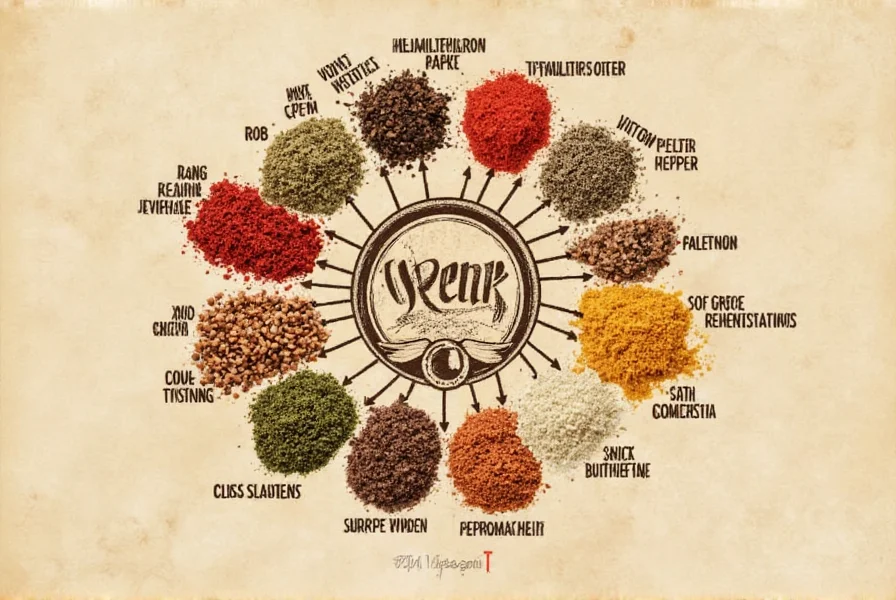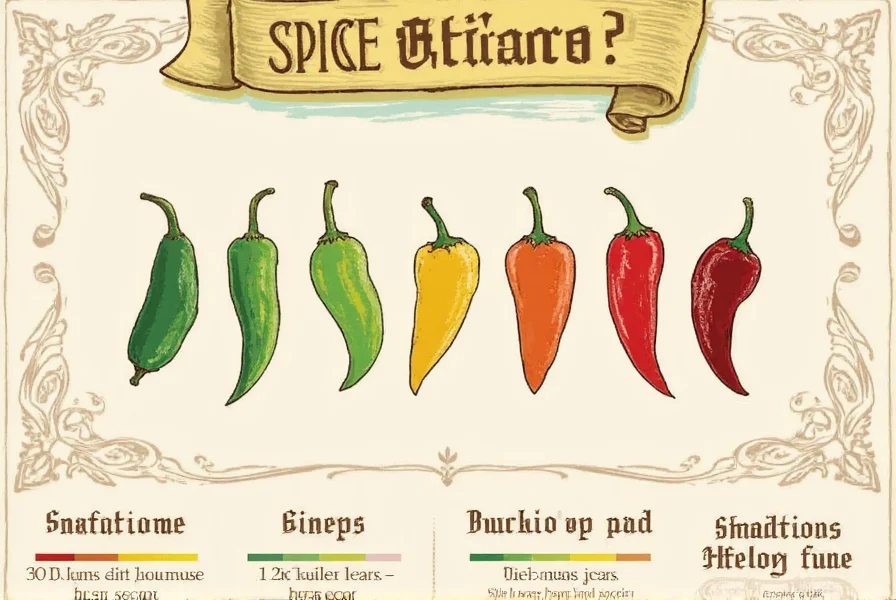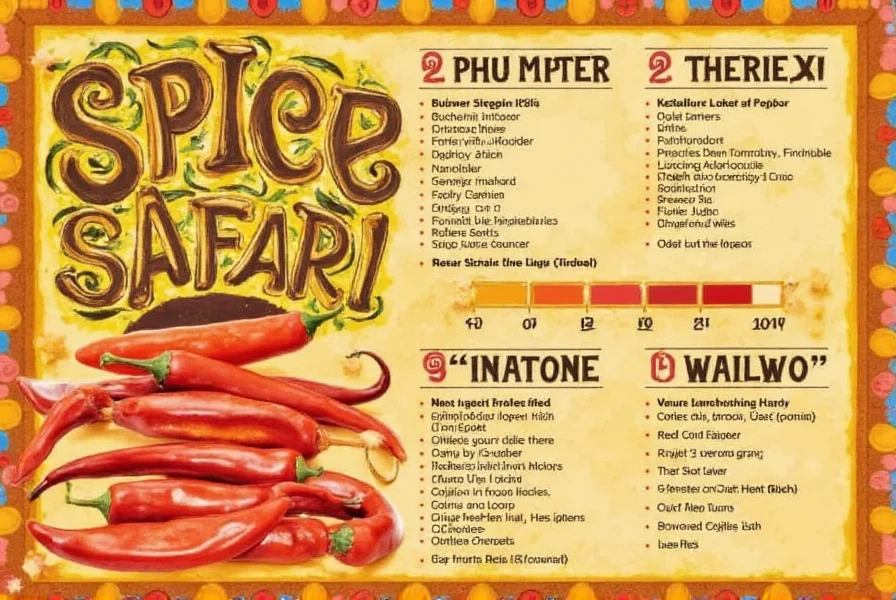The Scoville Heat Scale measures the spiciness of chili peppers in Scoville Heat Units (SHU). Developed by pharmacist Wilbur Scoville in 1912, this scale helps you understand how hot different peppers are. The world's hottest pepper, the Carolina Reaper, has a Scoville rating of 1.4 to 2.2 million SHU, while mild bell peppers have 0 SHU. This comprehensive guide covers all popular chili peppers, their heat levels, and how to use them safely in your cooking.
Table of Contents
- What Is the Pepper Heat Scale?
- Top Peppers by Heat Level
- How to Read the Scoville Scale
- Practical Tips for Cooking with Hot Peppers
- Safety First: Handling Hot Peppers Like a Pro
- Buying Guide: Best Peppers by Heat Level
- When to Use Which Chili in Your Dishes
- Conclusion: Embrace the Heat, One Pepper at a Time
What Is the Pepper Heat Scale?
The Scoville Heat Scale, named after pharmacist Wilbur Scoville, measures how spicy a chili pepper is. It's expressed in Scoville Heat Units (SHU), which determine how much sugar water it would take to dilute the capsaicin in the pepper until the heat is undetectable. In simpler terms, the higher the number, the spicier the pepper!
Why It Matters
Understanding this scale helps you control the heat in your dishes. Whether you're cooking for a crowd or preparing something for a spice-sensitive friend, knowing where each pepper falls on the scale can save you from unintentionally setting mouths ablaze — or worse, under-seasoning a masterpiece. According to the Guinness World Records, the Carolina Reaper holds the title of the world's hottest pepper with an average rating of 1.6 million SHU.
Top Peppers by Heat Level
| Pepper Name | Scoville Heat Units (SHU) | Common Uses |
|---|---|---|
| Bell Pepper | 0 | Ratatouille, stuffed dishes, salads |
| Poblano | 1,000-2,000 | Mole sauce, stuffed peppers, chiles rellenos |
| Jalapeño | 2,500-8,000 | Salsas, nachos, jalapeño poppers, pickled snacks |
| Serrano | 10,000-23,000 | Fresh salsas, hot sauces, Mexican cuisine |
| Cayenne | 30,000-50,000 | Spice blends, rubs, hot sauces, seasoning |
| Thai Bird's Eye | 50,000-100,000 | Thai curries, stir-fries, soups, Asian cuisine |
| Habanero | 100,000-350,000 | Fruit-forward hot sauces, salsas, Caribbean dishes |
| Scotch Bonnet | 100,000-350,000 | Jamaican jerk seasoning, Caribbean stews, sauces |
| Ghost Pepper (Bhut Jolokia) | 855,000-1,041,427 | Extreme eating challenges, specialty sauces, pepper spray |
| Carolina Reaper | 1,400,000-2,200,000 | World record chilies, daredevil cuisine, hot sauce |
How to Read the Scoville Scale
Let's break down the categories so you can better understand what level of heat you're dealing with. This scoville scale for beginners is essential for choosing the right pepper for your dishes.
Mild (0-5,000 SHU)
- Bell Pepper
- Poblano
- Peppadew
These peppers add color and subtle flavor without overwhelming your palate. Great for beginners or families with mixed spice tolerance. If you're looking for mild peppers for beginners, these are perfect starting points.
Medium (5,000-50,000 SHU)
- Jalapeño
- Serrano
- Ancho (dried poblano)
Ideal for everyday cooking. These are common in Mexican and Tex-Mex cuisines and offer a nice kick that builds gradually. Perfect for those who want to explore medium heat without overwhelming their taste buds.
Hot (50,000-350,000 SHU)
- Thai Bird's Eye
- Cayenne
- Habanero
- Scotch Bonnet
If you like to sweat while you eat, these are your go-to chilies. Perfect for bold sauces and fiery dishes that make your eyes water — in a good way. These are excellent for adding heat to Asian stir-fries or Caribbean dishes.
Extreme (Over 855,000 SHU)
- Ghost Pepper (Bhut Jolokia)
- Carolina Reaper
Handle with care! These peppers are best used sparingly or even avoided unless you have a high pain threshold and plenty of milk nearby. The Carolina Reaper holds the Guinness World Records title for the hottest pepper on earth.

Practical Tips for Cooking with Hot Peppers
Ready to bring the fire into your kitchen? Here are some pro tips to help you master the art of cooking with hot peppers, including how to reduce heat in spicy food:
- Use gloves: Capsaicin sticks to your skin and can burn sensitive areas like your eyes. This is especially important when handling extreme peppers like the Carolina Reaper.
- Remove seeds and ribs: Most of the heat is concentrated there. Removing them softens the blow — perfect for those who want to enjoy flavor without excessive heat.
- Add acid: A splash of lime juice or vinegar can balance out the heat and enhance other flavors. This technique works well for salsa and hot sauce recipes.
- Pair with dairy: Milk, yogurt, or sour cream can neutralize the burn quickly. This is the best way to reduce heat in spicy food when it's too much.
- Toast dried chilies: Enhances flavor and reduces bitterness. Be careful not to overdo it, especially with medium heat peppers like jalapeños.
Safety First: Handling Hot Peppers Like a Pro
While cooking with spicy chilies can be thrilling, safety should never be an afterthought. Here's how to protect yourself, especially when working with extreme peppers:
- Wear gloves when slicing or seeding hot peppers. Capsaicin doesn't wash off easily — this is crucial for handling ghost peppers or Carolina Reapers.
- Avoid touching your face, especially eyes, nose, or mouth while handling peppers. This simple step prevents accidental burns.
- Wash cutting boards and knives thoroughly to prevent cross-contamination. Use hot soapy water for best results.
- Keep a dairy-based remedy nearby like milk, yogurt, or ice cream. Water won't help once the burn hits! This is the most effective way to reduce heat in spicy food.
- Don't use paper towels — they can trap capsaicin oils. Opt for dishcloths or paper-free cleaning tools for safer cleanup.

Buying Guide: Best Peppers by Heat Level
Whether you're shopping at a local farmers market or browsing online stores, here's a handy guide to help you pick the right pepper for your needs. This buying guide for peppers by heat level helps you choose the perfect chili for any dish.
Mild Heat Lovers
- Poblano Pepper: Earthy and slightly sweet. Ideal for stuffing or making mole sauce. Perfect for mild peppers for beginners.
- Peppadew: Sweet and tangy with a gentle heat. Perfect in salads or antipasti platters.
Medium Heat Enthusiasts
- Jalapeño: Versatile and widely available. Excellent grilled, roasted, or pickled. Great for those new to spicy food.
- Serrano Pepper: Smaller but punchier than jalapeños. Great for fresh salsas and Mexican dishes.
Hot & Bold
- Thai Bird's Eye: Tiny but mighty. Used heavily in Thai and Vietnamese cooking. Perfect for Asian stir-fries.
- Habanero: Fruity with intense heat. Popular in Caribbean jerk seasoning and fruit-based hot sauces.
Fire Breathers
- Carolina Reaper Powder: Easy to sprinkle and pack a serious punch. Great for seasoned salt blends and extreme heat challenges.
- Ghost Pepper Sauce: Intense and lingering. Not for the faint of heart. Best for experienced spice lovers.
When to Use Which Chili in Your Dishes
Choosing the right chili isn't just about heat — it's also about flavor and texture. Here's a quick guide on when to use which, including how to use hot peppers in cooking:
- For Fresh Salsas: Jalapeño, Serrano, Habanero (mild to medium heat for beginners, hot for experienced)
- For Roasting & Stuffing: Poblano, Anaheim (mild peppers for beginners)
- For Dried Chilies in Stews: Ancho, Guajillo, Pasilla (medium heat with rich flavor)
- For Asian Stir-Fries: Thai Bird's Eye, Fresno (hot peppers for authentic Asian dishes)
- For Homemade Hot Sauces: Cayenne, Habanero, Scotch Bonnet (medium to hot peppers for balanced flavor)
- For Extreme Challenges: Carolina Reaper, Ghost Pepper (use sparingly for serious heat seekers)
Conclusion: Embrace the Heat, One Pepper at a Time
Whether you're chasing the thrill of extreme heat or prefer a slow-building warmth, the pepper heat scale list is your roadmap to flavor paradise. Understanding the SHU range empowers you to create dishes that cater to your taste buds and those of your guests. This scoville scale for beginners will help you confidently select the perfect pepper for any recipe.
So next time you reach for a pepper, don't just ask "Is it spicy?" — ask "How spicy does it need to be?" With this guide in hand, you're well on your way to becoming a true chili connoisseur. Now go forth and season boldly — but wisely! Remember to always practice safe handling techniques, especially when working with extreme peppers.











 浙公网安备
33010002000092号
浙公网安备
33010002000092号 浙B2-20120091-4
浙B2-20120091-4